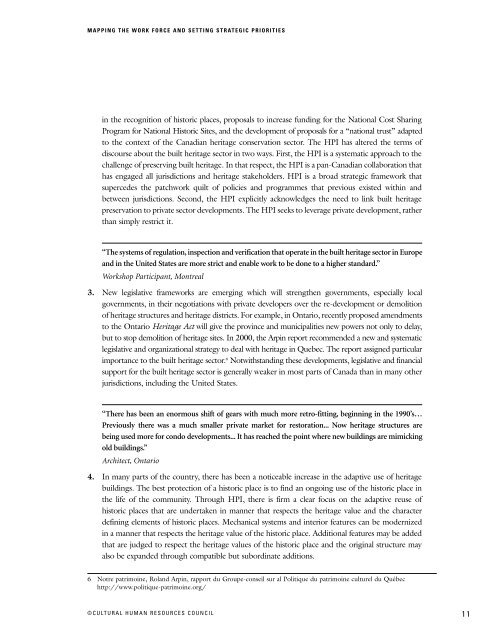Human Resources in Canada's Built Heritage Sector: Mapping the ...
Human Resources in Canada's Built Heritage Sector: Mapping the ...
Human Resources in Canada's Built Heritage Sector: Mapping the ...
- No tags were found...
Create successful ePaper yourself
Turn your PDF publications into a flip-book with our unique Google optimized e-Paper software.
MAPPING THE WORK FORCE AND SETTING STRATEGIC PRIORITIES<strong>in</strong> <strong>the</strong> recognition of historic places, proposals to <strong>in</strong>crease fund<strong>in</strong>g for <strong>the</strong> National Cost Shar<strong>in</strong>gProgram for National Historic Sites, and <strong>the</strong> development of proposals for a “national trust” adaptedto <strong>the</strong> context of <strong>the</strong> Canadian heritage conservation sector. The HPI has altered <strong>the</strong> terms ofdiscourse about <strong>the</strong> built heritage sector <strong>in</strong> two ways. First, <strong>the</strong> HPI is a systematic approach to <strong>the</strong>challenge of preserv<strong>in</strong>g built heritage. In that respect, <strong>the</strong> HPI is a pan-Canadian collaboration thathas engaged all jurisdictions and heritage stakeholders. HPI is a broad strategic framework thatsupercedes <strong>the</strong> patchwork quilt of policies and programmes that previous existed with<strong>in</strong> andbetween jurisdictions. Second, <strong>the</strong> HPI explicitly acknowledges <strong>the</strong> need to l<strong>in</strong>k built heritagepreservation to private sector developments. The HPI seeks to leverage private development, ra<strong>the</strong>rthan simply restrict it.“The systems of regulation, <strong>in</strong>spection and verification that operate <strong>in</strong> <strong>the</strong> built heritage sector <strong>in</strong> Europeand <strong>in</strong> <strong>the</strong> United States are more strict and enable work to be done to a higher standard.”Workshop Participant, Montreal3. New legislative frameworks are emerg<strong>in</strong>g which will streng<strong>the</strong>n governments, especially localgovernments, <strong>in</strong> <strong>the</strong>ir negotiations with private developers over <strong>the</strong> re-development or demolitionof heritage structures and heritage districts. For example, <strong>in</strong> Ontario, recently proposed amendmentsto <strong>the</strong> Ontario <strong>Heritage</strong> Act will give <strong>the</strong> prov<strong>in</strong>ce and municipalities new powers not only to delay,but to stop demolition of heritage sites. In 2000, <strong>the</strong> Arp<strong>in</strong> report recommended a new and systematiclegislative and organizational strategy to deal with heritage <strong>in</strong> Quebec. The report assigned particularimportance to <strong>the</strong> built heritage sector. 6 Notwithstand<strong>in</strong>g <strong>the</strong>se developments, legislative and f<strong>in</strong>ancialsupport for <strong>the</strong> built heritage sector is generally weaker <strong>in</strong> most parts of Canada than <strong>in</strong> many o<strong>the</strong>rjurisdictions, <strong>in</strong>clud<strong>in</strong>g <strong>the</strong> United States.“There has been an enormous shift of gears with much more retro-fitt<strong>in</strong>g, beg<strong>in</strong>n<strong>in</strong>g <strong>in</strong> <strong>the</strong> 1990’s…Previously <strong>the</strong>re was a much smaller private market for restoration... Now heritage structures arebe<strong>in</strong>g used more for condo developments... It has reached <strong>the</strong> po<strong>in</strong>t where new build<strong>in</strong>gs are mimick<strong>in</strong>gold build<strong>in</strong>gs.”Architect, Ontario4. In many parts of <strong>the</strong> country, <strong>the</strong>re has been a noticeable <strong>in</strong>crease <strong>in</strong> <strong>the</strong> adaptive use of heritagebuild<strong>in</strong>gs. The best protection of a historic place is to f<strong>in</strong>d an ongo<strong>in</strong>g use of <strong>the</strong> historic place <strong>in</strong><strong>the</strong> life of <strong>the</strong> community. Through HPI, <strong>the</strong>re is firm a clear focus on <strong>the</strong> adaptive reuse ofhistoric places that are undertaken <strong>in</strong> manner that respects <strong>the</strong> heritage value and <strong>the</strong> characterdef<strong>in</strong><strong>in</strong>g elements of historic places. Mechanical systems and <strong>in</strong>terior features can be modernized<strong>in</strong> a manner that respects <strong>the</strong> heritage value of <strong>the</strong> historic place. Additional features may be addedthat are judged to respect <strong>the</strong> heritage values of <strong>the</strong> historic place and <strong>the</strong> orig<strong>in</strong>al structure mayalso be expanded through compatible but subord<strong>in</strong>ate additions.6 Notre patrimo<strong>in</strong>e, Roland Arp<strong>in</strong>, rapport du Groupe-conseil sur al Politique du patrimo<strong>in</strong>e culturel du Québechttp://www.politique-patrimo<strong>in</strong>e.org/©CULTURAL HUMAN RESOURCES COUNCIL11










